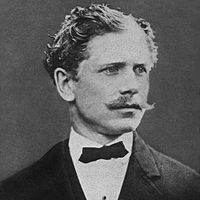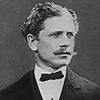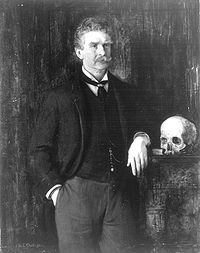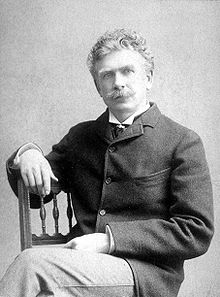- Ambrose Bierce
-
Ambrose Bierce 
Ambrose Bierce, ca. 1866Born June 24, 1842
Meigs County, Ohio, United StatesDied disappeared 1913,[1]
last seen in Chihuahua, Chihuahua, MexicoOccupation Journalist, Writer Genres Satire Literary movement Realism Notable work(s) "The Damned Thing", "An Occurrence at Owl Creek Bridge", The Devil's Dictionary, "Chickamauga"
Influences
Influenced- H.L. Mencken, William March, Jorge Luis Borges, Julio Cortázar, Stephen Crane, Ernest Hemingway
Signature 
Ambrose Gwinnett Bierce (June 24, 1842[2] – after December 26, 1913)[1] was an American editorialist, journalist, short story writer, fabulist and satirist. Today, he is best known for his short story, "An Occurrence at Owl Creek Bridge" and his satirical lexicon, The Devil's Dictionary. The sardonic view of human nature that informed his work – along with his vehemence as a critic, with his motto "nothing matters" – earned him the nickname "Bitter Bierce."
Despite his reputation as a searing critic, however, Bierce was known to encourage younger writers, including poet George Sterling and fiction writer W. C. Morrow. Bierce employed a distinctive style of writing, especially in his stories. This style often embraces an abrupt beginning (see cold open), dark imagery, vague references to time, limited descriptions, the theme of war, and impossible events.
In 1913, Bierce traveled to Mexico to gain a firsthand perspective on that country's ongoing revolution. While traveling with rebel troops, the elderly writer disappeared without a trace.
Contents
Early life and military career
Bierce was born at Horse Cave Creek in Meigs County, Ohio to Marcus Aurelius Bierce (1799–1876) and Laura Sherwood Bierce.[2] His mother was a descendant of William Bradford. His parents were a poor but literary couple who instilled in him a deep love for books and writing.[2] The boy grew up in Kosciusko County, Indiana, attending high school at the county seat, Warsaw.
He was the tenth of 13 children whose father gave all of them names beginning with the letter "A". In order of birth, the Bierce siblings were Abigail, Amelia, Ann, Addison, Aurelius, Augustus, Almeda, Andrew, Albert, Ambrose, Arthur, Adelia, and Aurelia. He left home at age fifteen to become a "printer's devil" at a small Ohio newspaper.[2]
At the outset of the American Civil War, Bierce enlisted in the Union Army's 9th Indiana Infantry Regiment. He participated in the Operations in Western Virginia campaign (1861), was present at the "first battle" at Philippi and received newspaper attention for his daring rescue, under fire, of a gravely wounded comrade at the Battle of Rich Mountain. In February 1862 he was commissioned First Lieutenant, and served on the staff of General William Babcock Hazen as a topographical engineer, making maps of likely battlefields.
Bierce fought at the Battle of Shiloh (April 1862), a terrifying experience that became a source for several later short stories and the memoir, "What I Saw of Shiloh". In June 1864, he sustained a serious head wound at the Battle of Kennesaw Mountain,[3] and spent the rest of the summer on furlough, returning to active duty in September. He was discharged from the army in January 1865.
His military career resumed, however, when in mid-1866 he rejoined General Hazen as part of the latter's expedition to inspect military outposts across the Great Plains. The expedition proceeded by horseback and wagon from Omaha, Nebraska, arriving toward year's end in San Francisco, California.
Personal life
Bierce married Mary Ellen ("Mollie") Day on Christmas Day 1871. They had three children; two sons, Day (1872–1889)[4] and Leigh (1874–1901),[4] and a daughter, Helen (1875–1940). Both of Bierce's sons died before him: Day was shot in a brawl over a woman,[4] and Leigh died of pneumonia related to alcoholism.[4] Bierce separated from his wife in 1888 after discovering compromising letters to her from an admirer, and the couple finally divorced in 1904.[4] Mollie Day Bierce died the following year.
Bierce suffered from lifelong asthma[4][5] as well as complications arising from his war wounds.[1]
Journalism
In San Francisco, Bierce received the rank of brevet major before resigning from the Army. He remained in San Francisco for many years, eventually becoming famous as a contributor and/or editor for a number of local newspapers and periodicals, including The San Francisco News Letter, The Argonaut, the Overland Monthly, The Californian and The Wasp. A selection of his crime reporting from The San Francisco News Letter was included in The Library of America anthology True Crime.
Bierce lived and wrote in England from 1872 to 1875, contributing to Fun magazine. His first book, The Fiend's Delight, a compilation of his articles, was published in London in 1873 by John Camden Hotten under the pseudonym "Dod Grile".[6][7] Returning to the United States, he again took up residence in San Francisco. From 1879 to 1880, he travelled to Rockerville and Deadwood in the Dakota Territory, to try his hand as local manager for a New York mining company, but when the company failed he returned to San Francisco and resumed his career in journalism.
In 1887, he published a column called "Prattle" and became one of the first regular columnists and editorialists to be employed on William Randolph Hearst's newspaper, the San Francisco Examiner,[2] eventually becoming one of the most prominent and influential among the writers and journalists of the West Coast. He remained associated with Hearst Newspapers until 1906.
Railroad Refinancing Bill
 Bierce's former residence (right) at 18 Logan Circle, in the Logan Circle neighborhood of Washington, D.C.
Bierce's former residence (right) at 18 Logan Circle, in the Logan Circle neighborhood of Washington, D.C.
The Union Pacific and Central Pacific railroad companies had received large loans from the U.S. government to build the First Transcontinental Railroad—on gentle terms, but Collis P. Huntington persuaded a friendly member of Congress to introduce a bill excusing the companies from repaying the money, amounting to $130 million (nearly $3 billion in 2007 money).
In January 1896 Hearst dispatched Bierce to Washington, D.C. to foil this attempt. The essence of the plot was secrecy; the railroads' advocates hoped to get the bill through Congress without any public notice or hearings. When the angered Huntington confronted Bierce on the steps of the Capitol and told Bierce to name his price, Bierce's answer ended up in newspapers nationwide:
My price is one hundred thirty million dollars. If, when you are ready to pay, I happen to be out of town, you may hand it over to my friend, the Treasurer of the United States.[8]Bierce's coverage and diatribes on the subject aroused such public wrath that the bill was defeated. Bierce returned to California in November.
McKinley accusation
Because of his penchant for biting social criticism and satire, Bierce's long newspaper career was often steeped in controversy. On several occasions his columns stirred up a storm of hostile reaction which created difficulties for Hearst. One of the most notable of these incidents occurred following the assassination of President William McKinley when Hearst's opponents turned a poem Bierce had written about the assassination of Governor Goebel in 1900 into a cause célèbre.
Bierce meant his poem, written on the occasion of the assassination of Governor William Goebel of Kentucky, to express a national mood of dismay and fear, but after McKinley was shot in 1901 it seemed to foreshadow the crime:
- "The bullet that pierced Goebel's breast
- Can not be found in all the West;
- Good reason, it is speeding here
- To stretch McKinley on his bier."
Hearst was thereby accused by rival newspapers—and by then Secretary of State Elihu Root—of having called for McKinley's assassination. Despite a national uproar that ended his ambitions for the presidency (and even his membership in the Bohemian Club), Hearst neither revealed Bierce as the author of the poem, nor fired him.[9]
Literary works
Bierce was considered a master of "Pure" English by his contemporaries, and virtually everything that came from his pen was notable for its judicious wording and economy of style. He wrote in a variety of literary genres.
His short stories are held among the best of the 19th century, providing a popular following based on his roots. He wrote realistically of the terrible things he had seen in the war in such stories as "An Occurrence at Owl Creek Bridge", "The Boarded Window", "Killed at Resaca", and "Chickamauga".
In addition to his ghost and war stories, he also published several volumes of poetry. His Fantastic Fables anticipated the ironic style of grotesquerie that became a more common genre in the 20th century.
One of Bierce's most famous works is his much-quoted book, The Devil's Dictionary, originally an occasional newspaper item which was first published in book form in 1906 as The Cynic's Word Book. It consists of satirical definitions of English words which lampoon cant and political double-talk.
Under the entry "leonine", meaning a single line of poetry with an internal rhyming scheme, he included an apocryphal couplet written by the fictitious "Bella Peeler Silcox" (i.e. Ella Wheeler Wilcox) in which an internal rhyme is achieved in both lines only by mispronouncing the rhyming words:
- The electric light invades the dunnest deep of Hades.
- Cries Pluto, 'twixt his snores: "O tempora! O mores!"
Bierce's twelve-volume Collected Works were published in 1909, the seventh volume of which consists solely of The Devil's Dictionary, the title Bierce himself preferred to The Cynic's Word Book.
Disappearance
In October 1913 Bierce, then aged 71, departed Washington, D.C., for a tour of his old Civil War battlefields. By December he had proceeded through Louisiana and Texas, crossing by way of El Paso into Mexico, which was in the throes of revolution. In Ciudad Juárez he joined Pancho Villa's army as an observer, and in that role he witnessed the Battle of Tierra Blanca.
Bierce is known to have accompanied Villa's army as far as the city of Chihuahua. His last known communication with the world was a letter he wrote there to Blanche Partington, a close friend, dated December 26, 1913.[10][11] After closing this letter[12] by saying, "As to me, I leave here tomorrow for an unknown destination," he vanished without a trace, becoming one of the most famous disappearances in American literary history. Skeptic Joe Nickell, however, argued in his book Ambrose Bierce Is Missing and Other Historical Mysteries (1992) that such a letter had never been found. All that existed was Ms. Carrie Christiansen's notebook with a rough summary of a purported letter and her statement that the originals had been destroyed.
Oral tradition in Sierra Mojada, Coahuila, documented by the priest James Lienert, states that Bierce was executed by a firing squad in the town cemetery there.[13] Again, Nickell (1992) finds this story to be rather incredible. He quotes Bierce's friend and biographer Walter Neale as saying that in 1913, Bierce had not ridden for quite some time, was suffering from serious asthma, and had been severely critical of Pancho Villa. Neale concludes that it would have been highly unlikely for Bierce to have gone to Mexico and joined up with Villa.
However, all investigations into his fate have proven fruitless, and Nickell concedes that despite a lack of hard evidence that Bierce had gone to Mexico, there is also none that he had not. Therefore, despite an abundance of theories (including death by suicide), his end remains shrouded in mystery.
Legacy and influence
 Ambrose Bierce and his signature.
Ambrose Bierce and his signature.
At least three films have been made of Bierce's story "An Occurrence at Owl Creek Bridge". A silent film version, The Bridge, was made in 1929. A French version called La Rivière du Hibou, directed by Robert Enrico, was released in 1962; this black-and-white film faithfully recounts the original narrative using voice-over. Another version, directed by Brian James Egen, was released in 2005.
The French version was aired in 1964 as the final episode of the television series The Twilight Zone: "An Occurrence at Owl Creek Bridge". A copy of "An Occurrence at Owl Creek Bridge" appeared in the ABC television series Lost ("The Long Con", airdate February 8, 2006). Prior to The Twilight Zone, the story had been adapted as an episode of Alfred Hitchcock Presents.
Another notable film adaptation was made of Bierce's story "Eyes of the Panther". To date at least two versions of this story exist on screen. One version was developed for Shelley Duvall's Nightmare Classics series and was released in 1990. This version runs about 60 minutes and is widely criticized[who?] for being too loosely adapted. Another, shorter, version was released in 2006 by director Michael Barton and runs about 23 minutes.
American composer Rodney Waschka II composed an opera, Saint Ambrose, based on Bierce's life.[14]
Bierce's disappearance has also been a popular topic. Carlos Fuentes's novel The Old Gringo is a fictionalized account of Bierce's disappearance which was later adapted into the film Old Gringo (1989), starring Gregory Peck in the title role.[15] Bierce's disappearance and trip to Mexico provide the background for the vampire horror film From Dusk till Dawn 3: The Hangman's Daughter (2000), in which Bierce's character plays a central role. Bierce's fate is the subject of Gerald Kersh's "The Oxoxoco Bottle" (aka “The Secret of the Bottle”), which appeared in The Saturday Evening Post on December 7, 1957, and was reprinted in the anthology Men Without Bones. Bierce reappears in the future on Mount Shasta in Robert Heinlein's story, "Lost Legacy."
The short film "Ah! Silenciosa" (1999), starring Jim Beaver as Bierce, weaves elements of "An Occurrence at Owl Creek Bridge" into a speculation on Bierce's disappearance.
Biographer Richard O'Conner argued that war unleashed the howling demons lurking in the pit of Bierce's soul: "War was the making of Bierce as a man and a writer. [From his grim experience, he became] truly capable of transferring the bloody, headless bodies and boar-eaten corpses of the battlefield onto paper."[2]
Noted essayist Clifton Fadiman wrote: "Bierce was never a great writer. He has painful faults of vulgarity and cheapness of imagination. But...his style, for one thing, will preserve him; and the purity of his misanthropy, too, will help to keep him alive."[2]
Author Alan Gullette argues that Bierce's war tales may be the best writing on war, outranking his contemporary Stephen Crane (author of The Red Badge of Courage) and even Ernest Hemingway.[2]
Author Kurt Vonnegut once stated that he considered "Occurrence at Owl Creek Bridge" the greatest American short story and a work of flawless American genius.[citation needed]
Bibliography
Books
- The Fiend's Delight (1873) (tale)
- Cobwebs from an Empty Skull (1874) (short stories collection)
- The Dance of Death (with Thomas A. Harcourt and William Rulofson, as William Herman) (1877) (satiric work)
- Tales of Soldiers and Civilians (1891) (short stories collection)
- Black Beetles in Amber (1892) (poetry)
- The Monk and the Hangman's Daughter (1892) (tale)
- Can Such Things Be? (1893) (short stories collection)
- Fantastic Fables (1899) (short stories collection)
- The shadow on the dial, and other essays[16] (1909) (nonfiction, essays)
- The Devil's Dictionary (1911) (first published in book form as The Cynic's Wordbook, 1906) (nonfiction)
- Collected Works (1909) (short stories collection)
- Write It Right (1909) (nonfiction)
- A Horseman in the Sky, A Watcher by the Dead, The Man and the Snake (1920) (tales)
- A Vision of Doom: Poems by Ambrose Bierce (1980) (poetry)
- The Best of the Devil's Dictionary [17] (2011) (nonfiction)
- "Civil War Stories" [18] (2011) (short stories with autobiographical essay)
Short stories
- The Haunted Valley (1871)
- An Unfinished Race (1873)
- An Inhabitant of Carcosa (1887)
- Four Days in Dixie
- One of the Missing (1888)
- The Boarded Window (1891)
- Chickamauga (1891)
- The Eyes of the Panther (1891)
- Haita the Shepherd (1891)
- The Man and the Snake (1891)
- The Middle Toe of the Right Foot (1891)
- An Occurrence at Owl Creek Bridge (1891)
- The Suitable Surroundings (1891)
- A Tough Tussle (1891)
- A Watcher by the Dead (1891)
- An Adventure at Brownville (1893)
- A Baby Tramp (1893)
- Bodies of the Dead (1893)
- The Death of Halpin Frayser (1893)
- The Famous Gilson Bequest (1893)
- John Bartine's Watch (1893)
- The Night-Doings at "Deadman's" (1893)
- A Psychological Shipwreck (1893)
- The Realm of the Unreal (1893)
- The Secret of Macarger's Gulch (1893)
- The Damned Thing (1894)
- A Vine on a House (1905)
- The Moonlit Road (1907)[19]
- The Time the Moon Fought Back (1911)
- Beyond the Wall (1909)
- A Diagnosis of Death (1909)
- A Jug of Sirup (1909)
- Moxon's Master (1909)
- Staley Fleming's Hallucination (1909)
- The Stranger (1909)
- The Way of Ghosts (1909)
- The Affair at Coulter's Notch
- An Affair of Outposts
- The Applicant
- An Arrest
- The Baptism of Dobsho
- A Bottomless Grave
- The City of the Gone Away
- The Coup de Grace
- The Crime at Pickett's Mill (1888)
- Curried Cow
- The Failure of Hope and Wandel
- George Thurston
- A Holy Terror
- A Horseman in the Sky
- The Hypnotist[20]
- An Imperfect Conflagration[20]
- The Ingenious Patriot
- Jo. Dunfer. Done for
- John Mortonson's Funeral
- Jupiter Doke, Brigadier-General
- Killed at Resaca
- An Heiress from Redhorse
- The Little Story
- The Major's Tale
- The Man Out of the Nose
- The Mocking-Bird
- The Monk and the Hangman's Daughter
- Three and One Are One
- Mr Swiddler's Flip-Flap
- My Favourite Murder
- Mysterious Disappearances
- Oil of Dog
- One Kind of Officer
- One of Twins
- One Officer, One Man
- One Summer Night
- Parker Adderson, Philosopher
- Perry Chumly's Eclipse
- A Providential Intimation
- The Race at Left Bower
- A Resumed Identity
- Revenge
- A Revolt of the Gods
- Some Haunted Houses
- A Son of the Gods
- The Story of a Conscience
- The Tail of the Sphinx
- Visions of the Night
- The Widower Turmore
See also
- Bolesław Prus (career similarities).
- Fable
- John P. Irish, mentioned in Bierce's book, Black Beetles in Amber
- List of horror fiction authors
- List of people who have mysteriously disappeared
References
- ^ a b c Ambrose Bierce – Biography and Works, at The Literature Network
- ^ a b c d e f g h Floyd, E. Randall (1999). The Good, the Bad, and the Mad: Some Weird People in American History. New York: Barnes & Noble Publishing, Inc.. p. 18. ISBN 978-0-7607-6600-2.
- ^ Ambrose Bierce Timeline. 1861–1867. The Civil War, at The Ambrose Bierce Project
- ^ a b c d e f Floyd, p. 19
- ^ Floyd, p. 20
- ^ Selected Letters, p.8
- ^ Morris (1999), p.143
- ^ Ambrose Bierce, mon amour
- ^ Morris (1999), p. 237.
- ^ Starrett, Vincent. Ambrose Bierce. W.M. Hill, 1920. p. 39
- ^ Selected Letters, pp 244+.
- ^ The letter is available in its entirety at The Ambrose Bierce Site.
- ^ See The Ambrose Bierce Site for photograph of a monument in the Sierra Mojada cemetery, erected by Father Lienert in 2004, with inscription stating that Bierce was shot there.
- ^ Waschka II, Rodney. Capstone Records, Saint Ambrose
- ^ Fuentes, Carlos, Gringo Viejo (Planeta, 2004) ISBN 978-968-6941-67-8
- ^ archive.org
- ^ The Best of the Devil’s Dictionary | Kellys Cove Press
- ^ Civil War Stories | Kellys Cove Press
- ^ In 2009, The Library of America selected this story for inclusion in its two-century retrospective of American Fantastic Tales, edited by Peter Straub.
- ^ a b publicliterature.org
- Bleiler, Everett (1948). The Checklist of Fantastic Literature. Chicago: Shasta Publishers. pp. 32, 147.
- De Castro, Adolphe (1929). Portrait of Ambrose Bierce (New York and London: Century).
- McWilliams, Carey (1929; reprinted 1967). Ambrose Bierce: A Biography, Archon Books.
- O'Conner, Richard (1967). Ambrose Bierce: a Biography, with illustrations, Boston, Little, Brown and Company.
- Bierce, Ambrose; Joshi, S.T.; Shultz, David E. A Much Misunderstood Man: Selected Letters of Ambrose Bierce. Ohio State University Press, 2003.
- Morris, Roy. Ambrose Bierce: alone in bad company. Oxford University Press US, 1999. ISBN 978-0-19-512628-0.
Research resources
- Ambrose Bierce Papers, 1872–1913 (2 linear ft.) are housed in the Department of Special Collections and University Archives at Stanford University Libraries.
- The Ambrose Bierce Papers, ca. 1894–1913 and the Collection of Ambrose Bierce Papers, 1875–1925, bulk 1890–1913 are housed at The Bancroft Library.
- Nickell, J. (1992). Ambrose Bierce is missing and other historical mysteries. Lexington, KY: University Press of Kentucky.
External links
- General
- Ambrose Bierce at the Internet Movie Database
- Original Ambrose Bierce Site
- Works by Ambrose Bierce at Project Gutenberg
- The Ambrose Bierce Project
- Ambrose Bierce at PoetryFoundation.org
- Selected works
- The Devil's Dictionary hypertext from American Studies at the University of Virginia.
- Tales of Soldiers and Civilians
- One of Bierce's last letters
Works by Ambrose Bierce Short stories An Unfinished Race (1873) · Killed at Resaca (1877) · An Inhabitant of Carcosa (1887) · A Horseman in the Sky (1889) · An Occurrence at Owl Creek Bridge (1890) · The Damned Thing (1894) · The Moonlit Road (1907) · Moxon's Master (1909)

Short story collections Tales of Soldiers and Civilians (1891)
Non-fiction The Devil's Dictionary (1906)
Poetry A Vision of Doom (1980)
Categories:- 1842 births
- American satirists
- American short story writers
- American columnists
- American horror writers
- American poets
- Aphorists
- Fabulists
- Hearst Corporation people
- People of Indiana in the American Civil War
- People of the Mexican Revolution
- The San Francisco Examiner people
- Union Army officers
- People from Meigs County, Ohio
- People from San Francisco, California
- Writers from Ohio
- Writers from California
- American people of English descent
- Missing people
- Cthulhu Mythos writers
Wikimedia Foundation. 2010.


